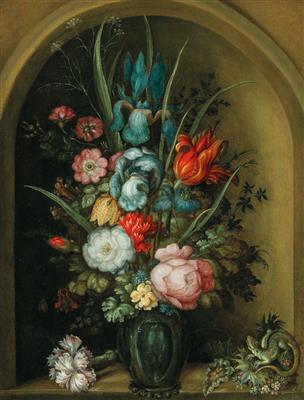Roelant Savery

(Courtrai 1576–1639 Utrecht)
Mixed flowers in a glass vase with a lizard nearby,
signed lower centre: ROELANDT SAVERY FE,
oil on copper, 31 x 24.5 cm, framed
Provenance:
with Eugene Slatter, London, 1957;
with Noortman Master Paintings, 2007
Literature:
K. J. Müllenmeister, Roelant Savery 1576-1639 Hofmaler Kaiser Rudolf II in Prag; Die Gemälde mit kritischem Oeuvrekatalog, Freren 1988, p. 341, cat. no. 292, p. 340 illustrated
The present copper is one of only twenty-five authentic floral still lifes known by Roelandt Savery, arguably the Gouden Eeuw’s foremost pioneer and finest painter of such pieces. In the present picture, Savery masterfully combines diverse flower types, which could never have bloomed in the same season, with subtle religious imagery that would have been understood by any contemporary collector of this jewel-like work. Kurt Müllenmeister, author of the monograph on the artist, dates the present copper to around 1612, noting the delicateness of the rendering of the blossoms and petals, along with the narrow bouquet format, characteristics which begin to appear in his works in the 1610s. Savery must have made a multitude of expertly observed and carefully recorded studies of the individual blooms in the present picture.
The fallen carnation on the left of the ledge of the stone niche may be read as a reflection on the transience of human life. This iconographic conceit is carefully balanced by placing a lizard on the lower right – symbolizing The Resurrection, through the shedding of its skin. The iris which crowns the bouquet is said to symbolise the majesty of the divine, while the Forget-me-not was at the time also known as an Oculus Christi, or a symbol of Christ’s omniscience.
Roelant Savery came from a Flemish family of painters, training with his elder brother Jacob and Hans Bol, a late Northern mannerist landscape master who had an important role in propagating the further spread of the visual models and themes of Pieter Brueghel the Elder (1525/30–1569). Fleeing Spanish persecution, Savery’s family settled in Haarlem where he was trained, before the young artist set out on his formative journey to Prague. Becoming court painter to Emperor Rudolf II, Savery studied the flora and fauna of the monarch’s extensive hunting grounds, before being sent on an expedition to Tyrol by Rudolf to study the plants there. An exceptional painter of birds, he trained Gillis d’Hondecoeter (c. 1575–1638). In 1616 Savery moved back to the Netherlands, setting up a studio in Utrecht where, along with his friends Ambrosius Bosschaert (1573–1621) and Balthasar van der Ast (1593/94–1657), he was the most celebrated painter of floral still-lifes.
Esperto: Damian Brenninkmeyer
 Damian Brenninkmeyer
Damian Brenninkmeyer
+43 1 515 60 403
oldmasters@dorotheum.com
08.06.2021 - 16:00
- Prezzo realizzato: **
-
EUR 247.300,-
- Stima:
-
EUR 200.000,- a EUR 300.000,-
Roelant Savery
(Courtrai 1576–1639 Utrecht)
Mixed flowers in a glass vase with a lizard nearby,
signed lower centre: ROELANDT SAVERY FE,
oil on copper, 31 x 24.5 cm, framed
Provenance:
with Eugene Slatter, London, 1957;
with Noortman Master Paintings, 2007
Literature:
K. J. Müllenmeister, Roelant Savery 1576-1639 Hofmaler Kaiser Rudolf II in Prag; Die Gemälde mit kritischem Oeuvrekatalog, Freren 1988, p. 341, cat. no. 292, p. 340 illustrated
The present copper is one of only twenty-five authentic floral still lifes known by Roelandt Savery, arguably the Gouden Eeuw’s foremost pioneer and finest painter of such pieces. In the present picture, Savery masterfully combines diverse flower types, which could never have bloomed in the same season, with subtle religious imagery that would have been understood by any contemporary collector of this jewel-like work. Kurt Müllenmeister, author of the monograph on the artist, dates the present copper to around 1612, noting the delicateness of the rendering of the blossoms and petals, along with the narrow bouquet format, characteristics which begin to appear in his works in the 1610s. Savery must have made a multitude of expertly observed and carefully recorded studies of the individual blooms in the present picture.
The fallen carnation on the left of the ledge of the stone niche may be read as a reflection on the transience of human life. This iconographic conceit is carefully balanced by placing a lizard on the lower right – symbolizing The Resurrection, through the shedding of its skin. The iris which crowns the bouquet is said to symbolise the majesty of the divine, while the Forget-me-not was at the time also known as an Oculus Christi, or a symbol of Christ’s omniscience.
Roelant Savery came from a Flemish family of painters, training with his elder brother Jacob and Hans Bol, a late Northern mannerist landscape master who had an important role in propagating the further spread of the visual models and themes of Pieter Brueghel the Elder (1525/30–1569). Fleeing Spanish persecution, Savery’s family settled in Haarlem where he was trained, before the young artist set out on his formative journey to Prague. Becoming court painter to Emperor Rudolf II, Savery studied the flora and fauna of the monarch’s extensive hunting grounds, before being sent on an expedition to Tyrol by Rudolf to study the plants there. An exceptional painter of birds, he trained Gillis d’Hondecoeter (c. 1575–1638). In 1616 Savery moved back to the Netherlands, setting up a studio in Utrecht where, along with his friends Ambrosius Bosschaert (1573–1621) and Balthasar van der Ast (1593/94–1657), he was the most celebrated painter of floral still-lifes.
Esperto: Damian Brenninkmeyer
 Damian Brenninkmeyer
Damian Brenninkmeyer
+43 1 515 60 403
oldmasters@dorotheum.com
|
Hotline dell'acquirente
lun-ven: 10.00 - 17.00
old.masters@dorotheum.at +43 1 515 60 403 |
| Asta: | Dipinti antichi I |
| Tipo d'asta: | Asta in sala con Live Bidding |
| Data: | 08.06.2021 - 16:00 |
| Luogo dell'asta: | Wien | Palais Dorotheum |
| Esposizione: | 29.05. - 08.06.2021 |
** Prezzo d'acquisto comprensivo di tassa di vendita e IVA
Non è più possibile effettuare un ordine di acquisto su Internet. L'asta è in preparazione o è già stata eseguita.
